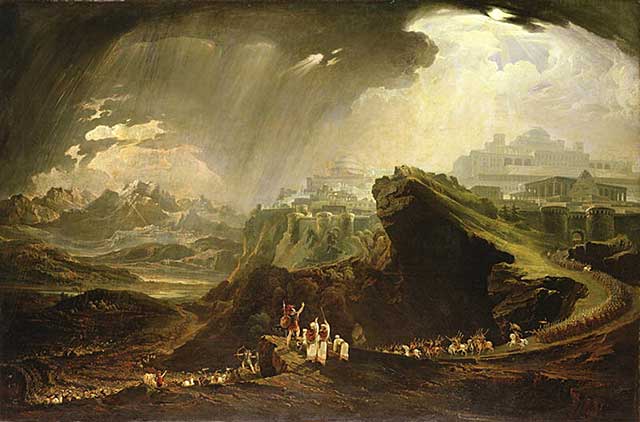Joshua Commanding the Sun to Stand Upon Gideon, 1816
Oil on Canvas
18 7/8 x 42 5/8 in
Yale Center for British Art, Paul Mellon Collection (1840 version)
“Painter of historical and biblical scenes, and landscape. Born at Eastland Ends,
a cottage near Haydon Bridge, Northumberland. Apprenticed to a coach painter in Newcastle,
but ran away to study painting with an Italian, Boniface Musso. 1806 came to London,
and at first worked as a china painter. Began exhibiting at the RA in 1811. His grandiose
biblical scenes soon began to catch the popular imagination, and “Belshazzar’s Feast’,
which made him famous, became through engravings one of the most popular pictures
of the age. Exhibited at RA 1811-52, BI, SS, NWS and elsewhere. He continued to paint
similar subjects, such as ‘The Plains of Heaven’, ‘The Great Day of His Wrath’, ‘The
Last Judgement’, which were scorned by Ruskin and the critics, but enjoyed enormous
popular appeal. Although his technique and colouring were sometimes deficient, he
had an undoubted ability to convey a sense of awe-inspiring grandeur, which has often
been compared to the methods of modern epic films. He was also a watercolourist,
and a book illustrator. Even today, he is often referred to as ‘Mad Martin’, a sobriquet
which he does not deserve. Possibly it arises from confusion with his brother Jonathan,
who was insane, and earned considerable notoriety by trying to burn down York Minister.
Exhibitions of Martin’s work were held at the Hatton Gallery, Newcastle in 1951,
at the Whitechapel in 1953, the Laing AG, Newcastle in 1970 and at Hazlitt, Gooden
and Fox in 1975.”
Biographical Source: Wood, Christopher. The Dictionary of Victorian Painters.)


